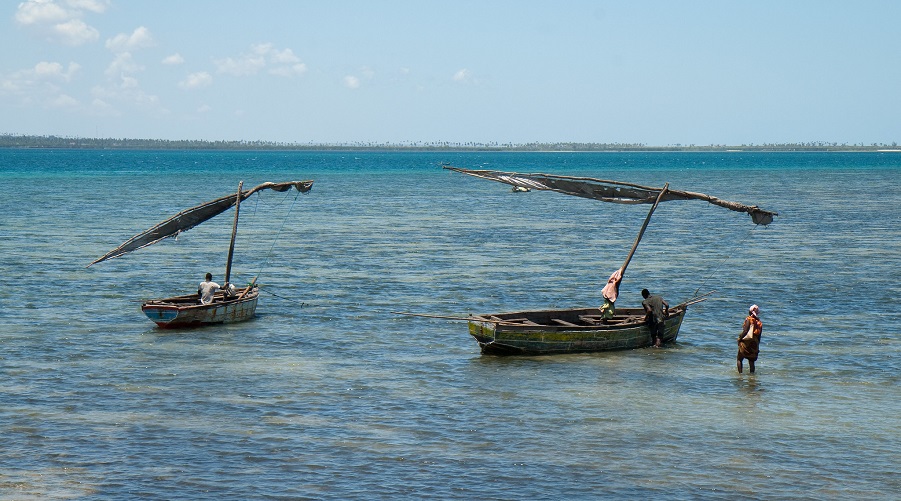
Traditional fishing pirogue in Madagascar. Photo by Jonathan Talbot, World Resources Institute, Flickr
Substantial growth in the number of motorized vessels operating in the Mozambique Channel region between East Africa and Madagascar in the past 65 years has led to a 60-fold increase in effective small-scale fishing effort and a 91 per cent decline in Catch Per Unit of Effort (CPUE).
A new study by researchers with the Sea Around Us – Indian Ocean at the University of Western Australia and the Sea Around Us at the University of British Columbia estimated the effective fishing effort for small-scale fisheries in the Union of Comoros, Madagascar, Mayotte, and Mozambique. To estimate it, the group used the number, length, motorization or engine power, and days of fishing of small-scale fishing vessels operating in each of these countries/territories, and used equivalencies of these measures for shore-based fishers without boats.
They found that effective small-scale fishing effort in the entire Mozambique Channel region grew slowly but steadily from around 386,000 kWdays in 1950 to around 23 million kWdays by 2016, with Mozambique and Madagascar dominating the upward trend.
“The increase in small-scale fishing effort we documented was the combined result of growth in both the number of boats as well as motorization of fleets,” Dirk Zeller, lead author of the study and director of the Sea Around Us – Indian Ocean said. “The popularization of motorization of traditional vessels, and the introduction of newer, larger powered vessels were important factors driving fishing effort trends.”
Once the fishing effort was estimated, it was combined with previously reconstructed small-scale catch data, which incorporates best estimates of unreported catches with data officially reported by countries to the UN’s Food and Agriculture Organization. From this, the researchers were able to determine the relationship between small-scale catches and the effort that is put into fishing, a measure known as Catch Per Unit of Effort (CPUE). CPUE time series can be useful indicators of changes in the relative abundance of fish resources, especially in areas with limited or no effective management.

Traditional fishing pirogue in Madagascar. Photo by Jonathan Talbot, World Resources Institute, Wikimedia Commons.
For the entire region, they identified a 91 per cent decline between 1950 and 2016 in small-scale catch per unit effort, which went from around 174 kg/kWday in 1950 to just over 15 kg/kWday by 2016. Mayotte and Mozambique saw the largest declines in the CPUE, with a 95 per cent and a 93 per cent fall since 1950, respectively.
These findings suggest strongly declining relative abundances of the underlying fished stocks.
“The pattern of CPUE observed here suggests a strongly declining fisheries resource base for the small-scale fisheries in these countries and territories over the last 60+ years,” said Daniel Pauly, co-author of the study and principal investigator of the Sea Around Us at UBC’s Institute for the Oceans and Fisheries. “This is important information not only because the growing population in this region heavily depends on artisanal and subsistence fishing for food security but also because the Mozambique Channel is an important corridor for migratory species like tuna.”
Tuna and tuna-like species in the area, however, are also caught by industrial fisheries and this creates competition for marine resources with the small-scale sector.
“The problem is that this competition, if not strictly managed, tends to exacerbate the socio-economic marginalization of the small-scale sector that feeds most of the population,” Zeller said. “For example, tuna caught by European Union vessels in Comoros waters are not landed in Comoros, nor are there observers aboard these vessels, despite it having been shown that full observer coverage is necessary for equitable resource use.”
The researchers say that fisheries managers and decision-makers in the region should take the declining CPUE as a serious warning sign of decreased abundance and biomass of the exploited fish populations and act. This means implementing effective effort restrictions and carefully consider the interaction between domestic and foreign fisheries when renewing or establishing future fishing agreements.
The study “Fishing effort and associated catch per unit effort for small-scale fisheries in the Mozambique Channel region: 1950-2016” was published in Frontiers in Marine Science, doi: https://doi.org/10.3389/fmars.2021.707999


